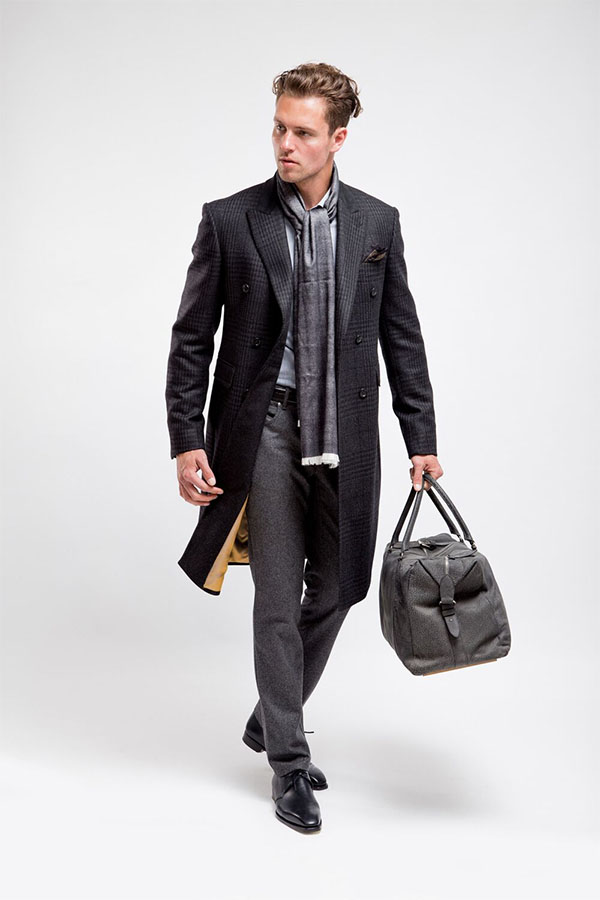This indispensable wardrobe staple is an important investment in any man’s wardrobe who would like to be remembered as a man of quality and influence. Originating from the military and the navy there are good reasons why they are still regarded as being a hall mark of men’s fashion. Forget all those technical fabrics and padded puffer jackets that are great for hill walking, climbing or weekend wear with jeans. These simply do not look the part if you are wearing a great suit, jacket or a quality piece of knit wear and a pair of moleskin or wool trousers. So, what do you need to consider to find the perfect coat?
Single or double breasted?
Much depends on your height and scale. As a general rule taller, broader men look better in a longer coat either single or double breasted with a broader lapel to balance the width across the chest. Where as shorter men tend to look more balanced in a shorter coat with a narrower lapel.
What styles are recommended?
The ‘Crombie’ coat is a quintessentially English coat in design for the military and also adopted by the hunting fraternity in the 19th century. A favoured style by everyone from the British monarchy, 1960’s film stars such as Carey Grant and most recently by David Beckham. It is a style replicated by many exclusive brands and is essentially a single breasted ¾ length style coat with velvet collar in a contrasting colour. This coat follows the body contours and needs to be tailored correctly to give the wearer a classic, stylish look, rather than it looking like you just purchased it ‘off the peg’.
Alternatively, you could consider the shorter ‘pea coat. It’s heritage lies in naval history. It is a popular style with younger customers as it is a slightly more casual coat. Its tailored silhouette translates well from work to weekend wear. So much more stylish than the ‘puffer jacket’ that makes all but the skinniest man look at least a stone heavier!
The perfect fit
You should really consider what you will wear under your coat you go for your initial appointment and subsequent fittings. Don’t just go with a T-Shirt or a shirt on otherwise you will end up with a coat that is far too close fitting if you want to wear a heavy knit sweater underneath it. Perhaps you are going to be wearing a jacket underneath? The main objective is that the coat covers all the layers worn underneath without anything poking out.
Particular attention should be to the sleeve length this is the one garment that needs to graze the hands. The collar is another area that needs to fit close to the neck. On some men their posture allows the wind to travel down the back of the neck like a funnel! This is why a good fitting made to measure garment ensures your scarf is more for show than keeping the wind out! Finally the chest area, although close fitting should not mean the buttons are pulling or creating any creasing.
What fabric should I choose?
Depending on your requirements 100% wool is a good starting point. The weight will dictate how warm the garment will be. If you intend to use it for standing outside on cold, frosty day watching football or rugby, or perhaps out shooting on the moors, then a heavier weight will serve you well. For something more luxurious and try cashmere mix with wool, pure cashmere, or, if you really want to pull out all the stops try vicuna mix!
Plain V Pattern?
Plain or flecks in navy or grey are very popular and easier on the dry-cleaning budget. If you want something more European, go for camel in finest cashmere or vicuna. Tweeds and herringbone are classically English country, while check and plain are more city focused. The question is where are you going to be spending most of your time and what do you want it for i.e. business or leisure?
Detail is everything
The exciting part about have a made to measure coat is choosing the linings, buttons, contrast stitching etc. You will be keeping this item for many years so really think carefully through your requirements do you want to be able to put your hands in your pockets? If yes then a slanted or vertical pocket detail will be easier to slip them in. If you want to carry something in your pocket without fear of loosing it then a larger square shaped horizontal pocket would be better. Finally, there some amazing linings that can transform a classic coat with a great talking point when you take it off!
Don’t be afraid to express your personality here. Even if you decide to go for a plain lining choose something more unusual colour wise and have your initials put on the inside breast pocket.
So there you have it lots to think about, and if you do decide to take the plunge Dean has some great examples to show you do contact him with any questions dean@saintcrispin.co.uk


